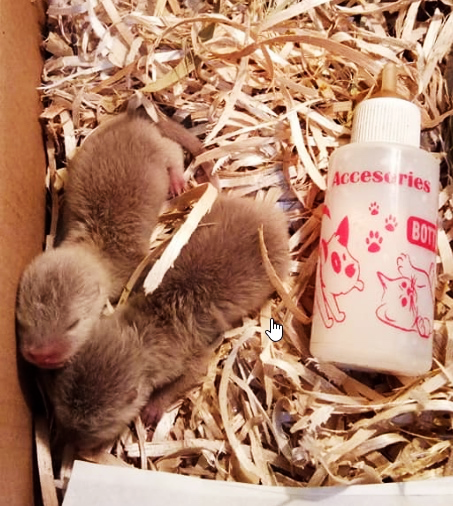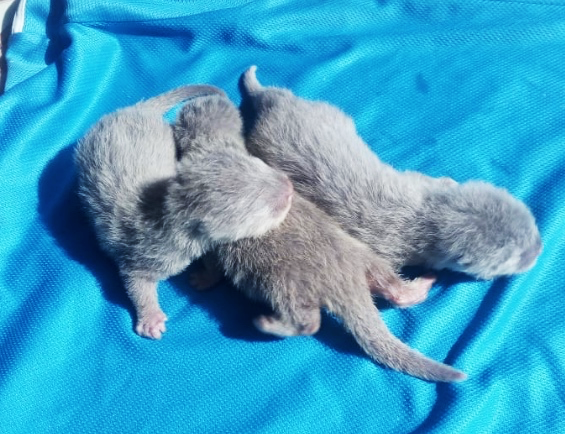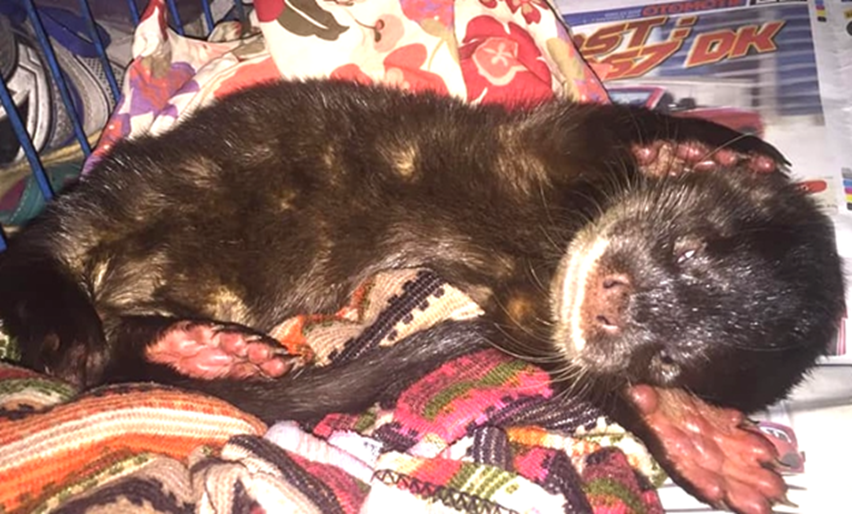IUCN/SSC Otter Specialist Group Bulletin

©IUCN/SCC Otter Specialist Group
Volume 36 Issue 2 (April 2019)Citation: Gomez, L, Shepherd, CR and Morgan, J (2019). Improved Legislation and Stronger Enforcement Actions needed as the Online Otter Trade in Indonesia continues. IUCN Otter Spec. Group Bull. 36 (2): 64 - 71
Improved Legislation and Stronger Enforcement Actions needed as the Online Otter Trade in Indonesia continues
Lalita Gomez, Chris R. Shepherd and John Morgan
Monitor Conservation Research Society, PO Box 200, Big Lake Ranch, BC, V0L 1G0, Canada, e-mail lalita.gomez@mcrsociety.org
Received 23rd April 2019, accepted 24th April 2019
Abstract: Indonesia is home to four species of otters i.e. Small-clawed Otter, Smooth-coated Otter, Hairy-nosed Otter and the Eurasian Otter. The latter three are protected by law in Indonesia. However, recent studies have shown that it is the Small-clawed Otter that is currently being coveted for the pet trade. Indonesia has been recently flagged as a hotspot in the trade of the Small-clawed Otter as pets. Online monitoring has shown hundreds of juveniles for sale, and anecdotal evidence suggests that much of this trade involves otters taken from the wild. This is concerning as the Small-clawed Otter is generally considered to be in decline across its range and listed as Vulnerable on the IUCN Red List of Threatened Species. This study shows that there is an urgent need for Indonesia to protect its Small-clawed Otter from over-exploitation. There is also an urgent need to stronger legislation in Indonesia concerning the regulation of wildlife trade occurring on online platforms.
Keywords: Indonesia, online wildlife trade, otters
INTRODUCTION
Indonesia is well known as a major hub of illegal and unsustainable wildlife trade: as a source, transit and consumer country, that involves a long and growing list of species (Shepherd, 2000, Soehartono and Mardiastuti, 2002; Sodhi et al., 2004; Stengel et al., 2011; Eaton et al., 2015). Recently, Indonesia has been implicated as a key player in the growing illegal trade of otters for the pet industry, both as a country of demand and a source of otters destined to international markets (Aadrean, 2013; Gomez et al., 2016; Gomez and Bouhuys, 2018; Kitade and Naruse, 2018). Hunting for trade is considered to be one of the key reasons for the depletion of otter species throughout much of Asia (Duckworth and Hills, 2008; Duplaix and Savage, 2018).
Indonesia is home to four species of otters - the Eurasian Otter Lutra lutra, Hairy-nosed Otter L. sumatrana, Small-clawed Otter Aonyx cinereus and the Smooth-coated Otter Lutrogale perspicillata. Of the four, the Eurasian and Hairy-nosed otters have been protected in Indonesia at least since 1999 under the Government Regulation No.7, 1999, Concerning the preservation of flora and fauna. In July 2018, the Indonesian government launched a revised list of protected species, which now includes the Smooth-coated Otter (Gomez and Shepherd, 2018). As protected species, they are protected from harvest or trade unless it involves second generation (F2) captive-bred individuals, which may only be bred by traders under special permit. Violation of the law can result in a five-year prison sentence and a fine of IDR100 million (USD7 200) under the Act of the Republic of Indonesia No.5 of 1990 concerning conservation of living resources and their ecosystem. The only otter not protected by law is the Small-clawed Otter. Nevertheless, no harvest quotas currently exist for this species which should, in essence, protect it from being harvested from the wild. Unfortunately, it is currently the most frequently encountered otter species in the pet trade due to its desirability as a pet (Gomez et al. 2016; Gomez and Bouhuys, 2018).
The pet trade has emerged as one of the most pressing threats to the survival of otters, particularly in Indonesia (Duplaix and Savage, 2018; Gomez and Bouhuys, 2018). Furthermore, studies show that much of this trade is being conducted online within the country (Aadrean, 2013; Gomez et al., 2016; Gomez and Bouhuys, 2018). A four-month online survey between January and April 2018, revealed a minimum of 504 and a maximum of 917 otters observed for sale in Indonesia with just a survey effort of one hour per week (Gomez and Bouhuys, 2018).All published reports of otter trade in Indonesia have been made publicly available, and information regarding the illegal otter trade has been sent directly to the Government of Indonesia, however, enforcement efforts do not yet seem to be effective, as the trade continues to escalate. Recent anecdotal reports claim that otters are now being bred in Indonesia for commercial trade, but at present, the existence of a legitimate breeding centre in Indonesia cannot be verified. Surveys of wildlife pet markets in Indonesia revealed few otters for sale despite their popularity. In fact, there were more otters being sold on social media than were found in the wildlife pet markets across Java. Yet there appears to be little information available on the legislation regulating the online trade in otters or any other wildlife. Understanding the levels of online trade is therefore essential to inform and support policy, enforcement and conservation interventions, and as such this review of trade has been carried out to assess current levels of online trade in otters.
METHODS
Online surveys were conducted between 1 November 2018 and 31 January 2019. Only advertisements posted between August 2018 and January 2019 were recorded along with screenshots of each post. Online surveys were focussed on Indonesian Facebook wildlife trade groups (n = 48) and consisted of four hours of research per week, gathering as many advertisements on otters as possible. Facebook search filters were used to narrow down searches by year and month, and by trade group. While otters have various names in Indonesian language (berang-berang, anjing air and anjng sungai), the most commonly used was ‘otter’, which is why this was used as the key word for locating advertisements. Researchers collecting data were fluent in both Indonesian and English. Where possible, data was extracted from each advertisement and included location/base of operation of seller (if available), the species, quantity, age, price of otters on sale,name of the Facebook group, date of advertisement, etc. No personal data about the sellers were collected and no interaction with sellers took place. The number of otters being offered for sale were extracted directly from the posts when provided or were estimated based on the pictures provided or otherwise estimated to involve at minimum one individual. To avoid inflation of numbers, each post was cross-checked to remove duplicate records. The identification of otter species were based on the pictures provided where available and were verified by experts in the IUCN Otter Specialist Group.
RESULTS
From November 2018 to January 2019, a total of 216 advertisements offering an estimated 297 otters were recorded for sale on Facebook in Indonesia. This involved at least 19 Facebook Groups, of which there were eight Closed Groups, 11 Public Groups and one Secret Group, and involved 187 individual sellers. A Public Group and its posts can be viewed by everybody. A Closed Group can be found by anyone on Facebook, but only members of the Closed Group can see the Group’s posts. A Secret Group is invisible: only members of the Secret Group can find the Group on Facebook ’and see the Group’s posts.
Information on location of seller was available in 208 advertisements and all of these originated from the island of Java. The Province of West Java had the highest number with 106 posts, followed by Jakarta (n=50 posts), East Java (n=42 posts), Banten (n=6 posts) and Central Java (n=3 posts). These were mostly concentrated in the main cities of Jakarta (n=50 posts), Bogor (n=31 posts), Bandung (n=26 posts), Surabaya (n=19 posts) and Depok (n=18 posts).
At least two species of otter were observed for sale (Figs 1-3). The Small-clawed Otter was the most frequently observed, with an estimated 268 individuals for sale and at least one Hairy-nosed Otter was observed for sale. In 22 of the posts representing an estimated 28 individuals, the species was unidentifiable. This was either due to the otters being too young to distinguish between species, the pictures provided were not clear, or in some cases no picture was provided at all.
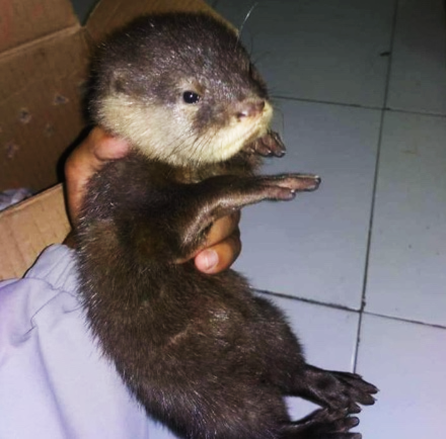
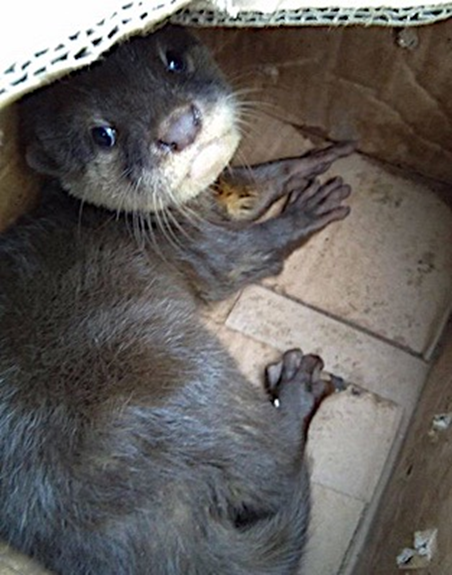
Of the 297 otters observed for sale, the majority ranged from new-borns to below 6-months of age Table 1). In 68 of the adverts representing 85 individuals, the age of the otter was not provided, but most appeared to be of juveniles based on pictures provided (i.e. <1 year of age).
The price data for otters was available in 159 adverts and ranged from IDR170K to IDR900K (~USD12-USD64) with an average of approximately IDR566K (~USD40). It is unclear how prices are determined as the range varies and overlaps between the different age groups. Nevertheless, in general, the average price for new-born otters, IDR413K (~USD29) were slightly lower in comparison to other age groups with average prices ranging between >IDR500K and IDR700K (~USD35 and USD50) (Table 1).
| Table 1: The age and price range of otters offered for sale on Facebook in Indonesia recorded between November 2018 and January 2019 | |||||
| Age
(months) |
# Adverts | # Animals | Price Range (IDR) | Average Price (IDR) | Average Price (USD*) |
| New-born<1 | 26 | 64 | 170K-600K | 413,824 | 29.82 |
| 1 | 2 | 4 | 800K | 800,000 | 56.60 |
| 1.5 | 4 | 4 | 400K-650K | 515,500 | 36.47 |
| 2 | 21 | 37 | 300K-900K | 546,667 | 38.68 |
| 2.5 | 7 | 10 | 350K-650K | 490,000 | 34.67 |
| 3 | 25 | 26 | 350K-750K | 558,333 | 39.50 |
| 3.5 | 1 | 1 | 650K | 650,000 | 45.99 |
| 4 | 9 | 9 | 450K-750K | 625,000 | 44.22 |
| 4.5 | 3 | 3 | 650K | 650,000 | 45.99 |
| 5 | 13 | 14 | 450K-850K | 645,455 | 45.67 |
| 6 | 10 | 10 | 500K-850K | 675,000 | 47.76 |
| 7 | 8 | 9 | 400K-700K | 540,000 | 38.21 |
| 8 | 9 | 9 | 300K-850K | 708,333 | 50.10 |
| 9 | 3 | 4 | 650K-700K | 675,000 | 47.76 |
| 10 | 1 | 1 | 500K | 500,000 | 35.38 |
| 11 | 1 | 1 | 500K | 500,000 | 35.38 |
| 12 | 2 | 2 | 700K | 700,000 | 49.53 |
| 15 | 1 | 1 | - | - | - |
| 24 | 1 | 1 | 800K | 800,000 | 56.60 |
| Not Stated | 68 | 85 | 250K-900K | 568,113 | 40.20 |
| *exchange rate as per https://www.oanda.com/currency/converter/ on 5 March 2019. It should be noted that the number of adverts and number of animals for sale is based on 219 adverts representing 297 otters for sale; the price range is based on 159 adverts that provided price data; and the ages presented here are based on data extracted from Facebook posts/adverts. | |||||
DISCUSSION AND CONCLUSION
According to the IUCN Red List of Threatened Species, the Small-clawed Otter is currently assessed as being Vulnerable (Wright et al., 2015), the Smooth-coated Otter as Vulnerable (de Silva et al., 2015), the Hairy-nosed Otter as Endangered (Aadrean et al., 2015) and the Eurasian Otter as Near Threatened (Roos et al., 2015). Populations of all four species are considered to be in decline. Illegal and unsustainable trade is increasingly a threat to these species and in Indonesia, despite evidence of illegal trade in otters being highlighted increasingly often in the media and in published papers, the trade appears to be growing and enforcement efforts do not
Otters, especially young animals, continue to be collected illegally from the wild, in violation of national legislation, and in the case of the Small-clawed Otter in violation of the zero-harvest quota, and sold locally and internationally. Outside of Indonesia, Japan continues to be a major consumer country of otters for the booming exotic pet trade there with many of these being sourced in Southeast Asia (Kitade and Naruse, 2018). More investigation into the trafficking of otters from Indonesia to Japan is required to map routes, identify smuggling methods and ultimately put an end to this crime. Anecdotal information indicates an increased number of businesses selling otters claimed to be bred in captivity, with at least some of these apparently destined for buyers in Japan. It is highly likely that these otters are in fact taken from the wild and fraudulently sold as being captive-bred. Indonesia’s legislation stipulates that animals sold as captive-bred must be second-generation (F2) under Government Regulation No.8 (1999), Concerning the utilization of wild plants and animals, and it is even less likely that these ‘breeders’ are breeding animals to the second generation. As has been shown to be the case with so many other species in Indonesia, unscrupulous traders are ignoring national laws and getting away with it, and as such, Indonesia’s wildlife, including otters, will continue to decline in the wild.
Currently, cybercrime in Indonesia is governed under Act No. 11 (2008), Concerning electronic information and transactions, and to a lesser extent, Act No.7 (2014) about Trade, and covers online trade transactions. However, none of these laws specifically address measures to regulate online wildlife trade and related crimes. The need for strong legislation in Indonesia to effectively tackle the trade in wildlife online has been raised in the past, and clearly is becoming more urgently needed. There is also an urgent need for Indonesia to protect its Small-clawed Otter from over-exploitation under Government Regulation No.7 (1999), Concerning the preservation of flora and fauna. Strong penalties must also be meted out for violating legislation preventing the illegal harvest, trade, purchasing and keeping otters and other illegally-sourced wildlife to serve as a strong deterrent. Further, the Government of Indonesia should investigate operations claiming to breed otters and take strong action against any found to be laundering otters from the wild or selling animals as captive-bred that are not in fact second generation bred in captivity. The government should also initiate dialogue with the Government of Japan, as the main international consumer of Southeast Asia’s otters for the pet trade, to jointly tackle this issue. Finally, otters should be included in campaigns to reduce the purchase and keeping of illegally and unsustainably sourced wildlife as pets.
Acknowledgements: We thank World Animal Protection (WAP) and the IUCN Otter Specialist Group for supporting this research. We also thank Nicole Duplaix for help in improving an earlier draft of this paper.
REFERENCES
Aadrean, A. (2013). An Investigation of Otters Trading as Pet in Indonesian Online Markets. Jurnal Biologika 2(1): 1–6.
Aadrean, A., Kanchanasaka, B., Heng, S., Reza Lubis, I., de Silva, P. and Olsson, A. (2015). Lutra sumatrana. The IUCN Red List of Threatened Species 2015: e.T12421A21936999. http://dx.doi.org/10.2305/IUCN.UK.2015-2.RLTS.T12421A21936999.en. Downloaded on 05 March 2019.
de Silva, P., Khan, W. A., Kanchanasaka, B., Reza Lubis, I., Feeroz, M. M. and Al-Sheikhly, O. F. (2015). Lutrogale perspicillata. The IUCN Red List of Threatened Species 2015: e.T12427A21934884. http://dx.doi.org/10.2305/IUCN.UK.2015-2.RLTS.T12427A21934884.en. Downloaded on 05 March 2019.
Duckworth, JW and DM Hills (2008) A Specimen of Hairy-Nosed Otter Lutra sumatrana from Far Northern Myanmar. IUCN Otter Spec. Group Bull. 25(1): 60 - 67
Duplaix, N. and M. Savage (2018). The Global Otter Conservation Strategy. IUCN/SSC Otter Specialist Group, Salem, Oregon, USA. https://www.otterspecialistgroup.org/osg-newsite/wp-content/uploads/2018/12/IUCN-Otter-Report-DEC%2012%20final_small.pdf
Eaton, J. A., Shepherd, C. R., Rheindt, F. E., Harris, J. B. C., van Balen, S. (B.), Wilcove, D. S. and Collar, N. J. (2015). Trade-driven extinctions and near-extinctions of avian taxa in Sundaic Indonesia. Forktail, 31: 1–12.
Gomez, L., Leupen, B.T.C., Theng, M., Fernandez, K. and Savage, M. (2016). Illegal Otter Trade: An analysis of seizures in selected Asian countries (1980–2015). TRAFFIC, Petaling Jaya, Selangor, Malaysia.
Gomez, L. and Bouhuys, J. (2018). Illegal Otter Trade in Southeast Asia. TRAFFIC, Petaling Jaya, Selangor, Malaysia. https://www.traffic.org/site/assets/files/5228/seasia-otter-report.pdf
Gomez, L. and Shepherd, C.R. (2018). Smooth-coated otter Lutrogale perspicillata receives formal protection in Indonesia, but Small - clawed otter Aonyx cinereus does not. IUCN Otter Spec. Group Bull. 35(2): . 128 - 130
Kitade, T. and Naruse, Y. (2018). Otter Alert: a rapid assessment of illegal trade and booming demand in Japan, TRAFFIC, Japan. https://www.traffic.org/site/assets/files/11196/otter-alert-vfinal-web-100.pdf
Roos, A., Loy, A., de Silva, P., Hajkova, P. and Zemanová, B. (2015). Lutra lutra. The IUCN Red List of Threatened Species 2015: e.T12419A21935287. http://dx.doi.org/10.2305/IUCN.UK.2015-2.RLTS.T12419A21935287.en. Downloaded on 05 March 2019.
Shepherd, C. R. (2000). Export of live Freshwater Turtles and Tortoises from North Sumatra and Riau, Indonesia: A Case Study. In: van Dijk, P.P., Stuart, B. L., and Rhodin, A. G. J. (eds), 2000. Asian Turtle Trade; Proceedings of a Workshop on Conservation and Trade of Freshwater Turtles and Tortoises in Asia. Chelonian Research Monographs, No. 2.
Sodhi, N. S., Koh, L. P., Brook, B. W. and Ng, P. K. L. (2004). Southeast Asian biodiversity: an impending disaster. TREE 19: 654–660.
Soehartono, T. and Mardiastuti, A., (2002). CITES implementation in Indonesia. Nagao Natural Environment Foundation, Jakarta, Indonesia.
Stengel, C. J., Shepherd, C. R. and Caillabet, O. S. (2011). The trade in tortoises and freshwater turtles in Jakarta, Indonesia revisited. TRAFFIC Southeast Asia, Petaling Jaya, Malaysia. https://www.traffic.org/site/assets/files/2688/tortoises_and_turtles_in_jakarta_report.pdf
Wright, L., de Silva, P., Chan, B. and Reza Lubis, I. (2015). Aonyx cinereus. The IUCN Red List of Threatened Species 2015: e.T44166A21939068. http://dx.doi.org/10.2305/IUCN.UK.2015-2.RLTS.T44166A21939068.en. Downloaded on 05 March 2019.
Résumé : Législation Adaptée et des Mesures Plus Strictes sont Nécessaires étant Donné que le Commerce des Loutres en Ligne se Poursuit en Indonésie
L’Indonésie accueille quatre espèces de loutres, à savoir la loutre cendrée, la loutre à pelage lisse, la loutre de Sumatra et la loutre eurasienne. Les trois dernières sont protégées par la loi en Indonésie. Cependant, des études récentes ont montré que c’est la loutre cendrée qui est actuellement recherchée pour le commerce des animaux de compagnie. L’Indonésie a récemment été désignée région stratégique du commerce de la loutre cendrée comme animal de compagnie. La surveillance en ligne a révélé la vente de centaines de juvéniles et des preuves inédites suggèrent qu'une grande partie de ce commerce concerne des loutres prélevées dans la nature. C’est préoccupant, car la loutre cendrée est généralement considérée comme en déclin dans son aire de répartition et classée comme vulnérable sur la liste rouge des espèces menacées de l'UICN. Cette étude montre que l'Indonésie a un besoin urgent de protéger la loutre cendrée contre la surexploitation. Il est également urgent de renforcer la législation indonésienne en matière de réglementation du commerce des espèces sauvages sur les plateformes en ligne.
Revenez au dessus
Resumen: Se Necesita Mejor Legislación y Control más Fuerte ante la Continuación del Comercio Online de Nutrias en Indonesia
Indonesia alberga cuatro especies de nutria: la de Uñas Pequeñas asiática, la Lisa, la de Sumatra y la Euroasiática. Las últimas tres están protegidas por ley en Indonesia. Sin embargo, estudios recientes han mostrado que es la de Uñas Pequeñas la que es actualmente buscada para el tráfico de mascotas. Indonesia ha sido recientemente señalada como un “hotspot” en el comercio de nutrias de Uñas Pequeñas como mascotas. El monitoreo online ha mostrado centenares de juveniles a la venta, y la evidencia anecdótica sugiere que mucho de este tráfico involucra nutrias capturadas en la naturaleza. Esto es preocupante, ya que la nutria de Uñas Pequeñas está considerada en declinación en toda su distribución, y está listada como Vulnerable en la Lista Roja de Especies Amenazadas de UICN. Este estudio muestra que hay una urgente necesidad de que Indonesia proteja sus nutrias de Uñas Pequeñas de la sobre-explotación. También hay una urgente necesidad de legislación más fuerte en Indonesia, concerniente a la regulación del comercio de fauna en plataformas online.
Vuelva a la tapa
